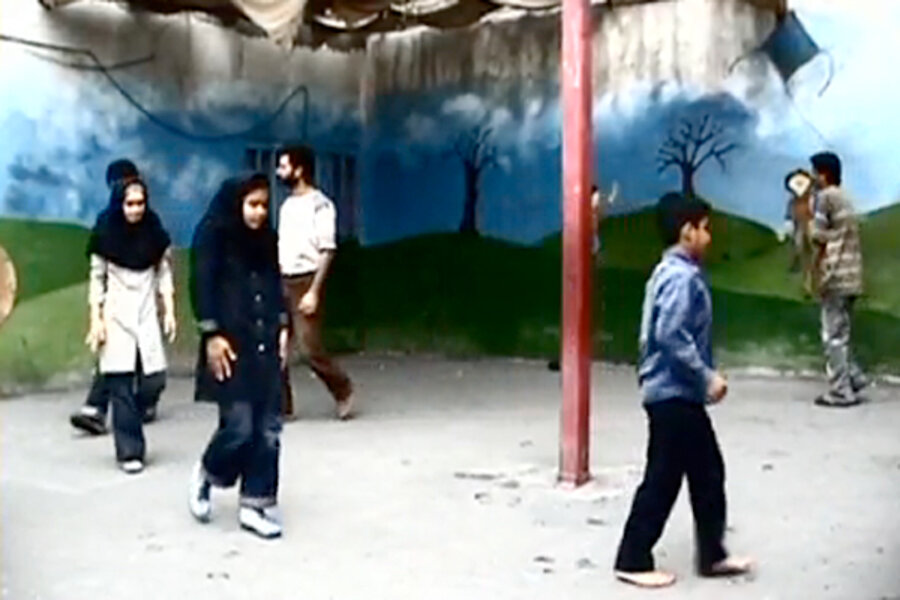In Tehran, Afghan refugee children find joy and dignity in theater [video]
Loading...
| Washington
In a recent documentary, “No Lips, No Laughter,” Iranian-American filmmaker Saba Farmanara provides an inspirational account of how art has helped a small theater troupe of young refugees define their individuality and find hope in a country where they have no official identity: the Islamic Republic of Iran.
Mr. Farmanara takes viewers to the inner courtyard of a Soviet-style apartment building with austere walls, hidden off a side street near south Tehran’s Shoosh Square.
There, instructor Hamid Pourazari’s small theater troupe has succeeded – with little money and few resources beyond the young students’ own talent and creativity – in transforming an abandoned courtyard into an oasis of hope within the sometimes harsh Tehran cityscape.
In one scene of the 36-minute film, a dozen or so children and teenagers – all Tehran residents – circle the building’s sparse courtyard, which is enclosed by cobalt-blue walls. Mr. Pourazari – a tall, darkly handsome man with mussed curly hair and wire-rimmed glasses – recites verses from a children’s poem by famed Iranian poet Ahmad Shamlou, directing the intensity of the youngsters’ movements as they wave their arms in concert to the poetry’s expressions of sorrow, hope, and patience.
“This is my one hour of the day where I can get away from my life ... and be someone else,” says Nessar Zarifi, a slender Afghan teenager with a soft smile and cropped black hair. “It’s as if I leave my body and enter someone else’s skin.”
More than 1.5 million undocumented Afghan refugees
The theater troupe represents just a sprinkling of Iran’s more than 1.5 million undocumented, unregistered Afghan refugees, many of whom were forced to flee Afghanistan during the Soviet occupation of the country or fled during the 1990s with the imposition of Taliban rule.
Denied a legal identity that would allow them to attend Iranian public schools and universities, most undocumented Afghan child refugees in the Islamic Republic must depend on nonprofit and nongovernmental organizations to acquire basic education and life skills. Many are unable to complete secondary school, and very few manage to move beyond the menial, labor-intensive jobs their parents are restricted to working for most of their lives.
The documentary reveals the story of seven Afghan refugee girls and boys, following their daily activities in Tehran as they rehearse for a play based on a children’s story by Shamlou, the poet. The children are filmed rehearsing in various locations throughout downtown Tehran – which is home to much of the city’s lower and middle income residents – as well as at school and in the verdant parks of Tehran’s upscale northern districts.
Finding true happiness
Shamlou’s story, called "The Man Without Lips," depicts the paradox of a man named Hossein-Gholi, who has all the physical and material things in life to make him happy, but has no lips for laughter. As Hossein-Gholi desperately struggles to find lips to laugh with and express his happiness, he comes to learn that it is not the physical image of a smile that defines true happiness, but a happy soul.
The children in Pourazari’s theater troupe personify Hossein-Gholi’s progression towards happiness because they aren’t chained to the material things that everyone else is held hostage to, says the film’s director in a phone interview.
“For these kids, the camaraderie that comes with working in theater and acting together in these classes is their way of finding laughter,” says Farmanara. “They’re not privileged, but make up for it with other things. These kids have the arts.”
An uncle helps Farmanara navigate a delicate topic
Creating a documentary in the Islamic Republic, where filmmakers must operate cautiously within the confines of the country’s stringent political climate, is a delicate affair.
And Farmanara wasn’t exactly a veteran when he started filming in December 2007. The young Iranian-American had no filmmaking experience before he decided to make a documentary about Iran, where he was born but left when he was 8 years old. A recent graduate of California State University at Northridge, Farmanara delayed completing his studies in order to take time off and move to the Iranian capital to make his film.
There he was mentored by his uncle, renowned Iranian director Bahman Farmanara, who introduced him to Pourazari’s unique theater troupe.
“It really interested me that there is a group of Afghan children who are working and acting in Iran,” says Farmanara, still in his 20s. “Meeting the director of the troupe and learning about the specific play they were working on alone made me commit 100 percent to filming them, even before I met the kids.”
"No Lips, No Laughter" focuses primarily on the experiences of one subset of young Afghan refugees living in Iran. But the trials, disappointments, and aspirations conveyed in the film reflect complexities that could be endured by an undocumented refugee living virtually anywhere.
Though addressing a politically sensitive issue within the Islamic Republic, the film manages to do so without directly referencing the Iranian government – adding yet one more graceful touch to an already touching film.





